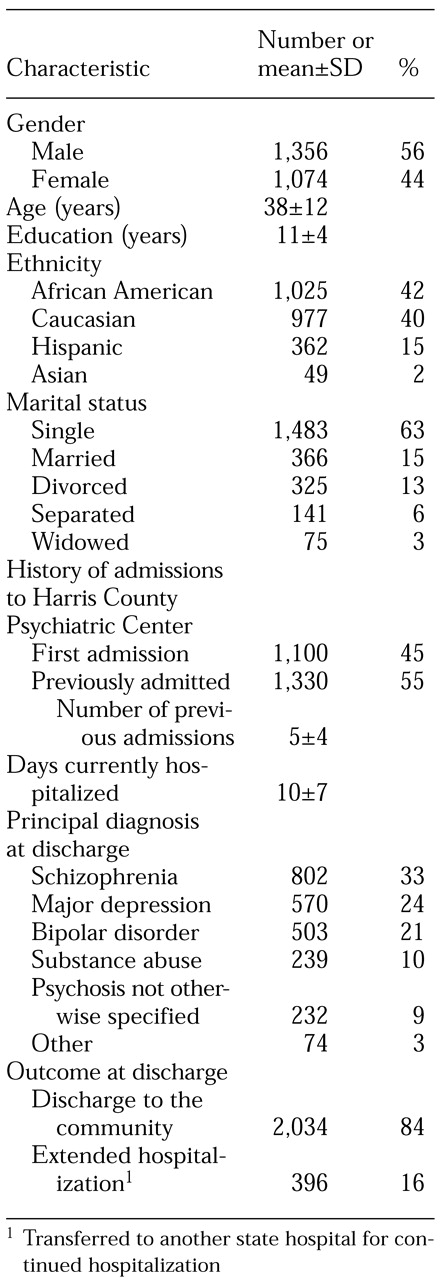Univariate analyses
Demographic variables. Chi square analyses revealed a significant difference for marital status in both the primary sample (χ2=31.6, df=4, p<.001, Φ=.16) and the replication sample (χ2=21.43, df=4, p<.01, Φ=.13). In the primary sample, single patients were more likely to be transferred for extended care (χ2=47.7, df=1, p<.001), whereas those who were married (χ2= 26.5, df=1, p<.001), divorced (χ2=5.08, df=1, p<.05), or separated (χ2=4.45, df=1, p<.05) were more likely to be discharged to the community. Discharge status did not differ among widowed patients.
In the replication sample, the same pattern was evident. Single patients were more likely to be discharged to extended care (χ2=48.58, df=1, p<.001), and those who were married (χ2=23.43, df=1, p<.001), divorced (χ2=4.36, df=1, p<.05), or separated (χ2=4.21, df=1, p<.05) were more likely to be discharged to the community. Again, discharge status did not differ among widowed patients.
Discharge status among individuals in the primary sample differed as a function of gender (χ2=9.1, df=1, p<.01, Φ=.09), ethnicity (χ2=14.5, df=3, p<.05, Φ=.11), and employment history (χ2=11.2, df=1, p<.01, Φ=.10); however, these variables were not significantly associated with discharge status in the replication sample.
Hospitalization variables. In the primary sample, patients who were transferred for extended care had more previous admissions to the Harris County Psychiatric Center than patients who were discharged to the community (F=72.5, df=1, 1,213, p<.001, est. η2=.06). They also had more previous transfers for extended care (F=130.63, df=1, 1,213, p<.001, est. η2=.10). These findings held for the replication sample (F=64.21, df=1, 1,213, p<.001, est. η2=.05, and F=106.37, df=1, 1,213, p<.001, est. η2=.08, respectively).
Clinician ratings. As indicated in
Table 2, patients in the primary sample who were transferred for extended care had higher BPRS-A total scores (F=54.74, df=1, 1,213, p<.001, est. η
2=.04) and higher scores for resistance (F=155.12, df=1, 1,213, p<.001, est. η
2=.11) and for positive symptoms (F=104.27, df=1, 1,213, p<.001, est. η
2=.08). However, patients who had higher scores for psychological discomfort were more likely to be discharged to the community (F=21.30, df=1, 1,213, p<.001, est. η
2=.02).
Analyses of the replication sample demonstrated the reliability of BPRS-A admission scores in predicting type of patient discharge. Patients who were transferred for extended care had higher total scores (F=81.19, df=1, 1,213, p<.001, est. η2=.06) and higher scores for resistance (F= 153.01, df=1, 1,213, p<.001, est. η2= .11) and positive symptoms (F= 136.97, df=1, 1,213, p<.001, est. η2= .11). Again, patients with higher scores for psychological discomfort were more likely to be discharged to the community (F=8.89, df=1, 1,213, p<.01, est. η2=.01).
Multivariate analyses
The final stage of data analysis involved examining the classificatory power of the three types of predictor variables—BPRS-A scores, demographic characteristics, and history of hospitalization—through stepwise discriminant function analyses. Only the six significant replicated variables were included in these analyses: marital status, dichotomized as single versus marital history; number of previous admissions to the Harris County Psychiatric Center; number of previous transfers for extended care; and scores on the BPRS-A subscales for resistance, positive symptoms, and psychological discomfort. Because of their shared variance with the factor scores, BPRS-A total scores were not included in these analyses.
The first analysis was conducted on the primary sample. All variables except number of previous admissions to the Harris County Psychiatric Center were retained (F= 63.53, df=5, 1,209, p<.001). In descending order of importance, the discriminant coefficients were BPRS-A resistance score (.52), number of previous transfers for extended care (.51), BPRS-A psychological discomfort score (-.37), BPRS-A positive symptoms score (.32), and marital status (-.13).
Four variables were replicated in the identical analysis conducted on the second sample (F=70.08, df=4, 1,210, p<.001). Number of previous admissions to the Harris County Psychiatric Center and marital status were not retained. In descending order of importance, the discriminant coefficients were BPRS-A resistance score (.48), BPRS-A positive symptoms score (.45), previous referrals for extended care (.44), and BPRS-A psychological discomfort score (-.30).
A final discriminant analysis was conducted on the entire sample and included the four variables that had been identified as robust predictors across both the primary and replication samples. These four variables were also found to be significant predictors in this final analysis (F=146.49, df=4, 2,425, p<.001); in descending order of importance, they were BPRS-A resistance score (.50), number of previous referrals for extended care (.49), BPRS-A positive symptoms score (.40), and BPRS-A psychological discomfort score (-.35). When this model was used, classification accuracy was 70 percent for extended hospitalization and 80 percent for community discharge. Overall classification accuracy was 78 percent.



